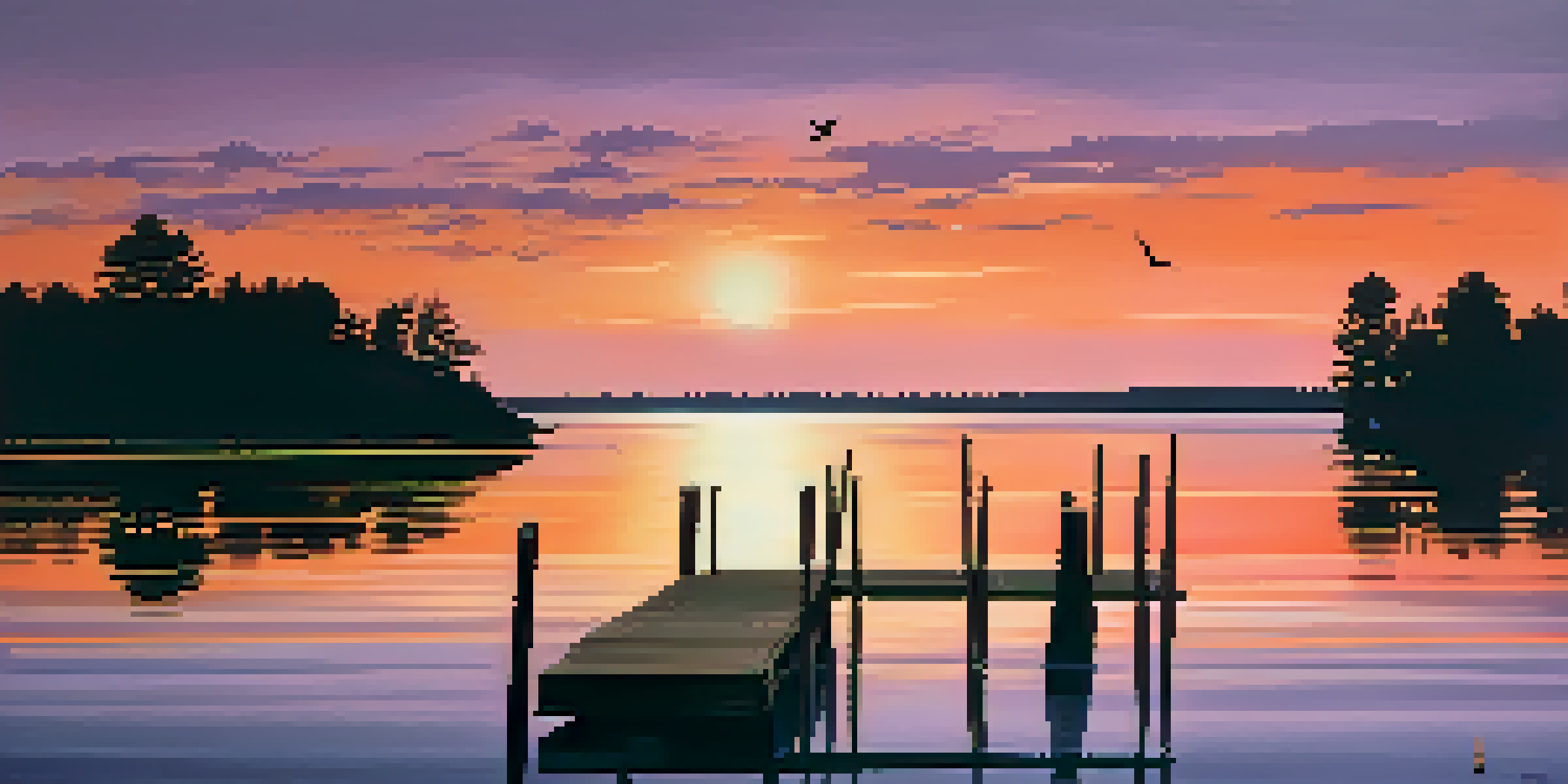New York's Great Lakes: Nature's Wonders and Resources

Introduction to New York's Great Lakes: Nature's Beauty
New York is home to an extraordinary natural treasure: the Great Lakes. These vast bodies of freshwater play a vital role in the state's ecology and economy. With their stunning landscapes and diverse ecosystems, the Great Lakes attract millions of visitors each year, offering a unique blend of recreation and relaxation.
The Great Lakes are a treasure for the state of New York, offering not only stunning beauty but also vital resources for its economy and ecology.
The Great Lakes, comprising Lakes Superior, Michigan, Huron, Erie, and Ontario, form the largest group of freshwater lakes in the world by total area. In New York, Lake Erie and Lake Ontario are particularly significant, serving as vital resources for both nature and industry. Their shores are dotted with charming towns, bustling cities, and breathtaking parks, making them a hub for outdoor enthusiasts.
From fishing and boating to hiking and birdwatching, the recreational opportunities are endless. Whether you're an avid nature lover or just looking for a weekend getaway, New York's Great Lakes provide a perfect escape into the heart of nature.
Ecological Significance of the Great Lakes
The ecological importance of New York's Great Lakes cannot be overstated. These lakes serve as critical habitats for a variety of fish, birds, and other wildlife. For instance, Lake Ontario is known for its rich biodiversity, including species like the lake trout and various migratory birds, making it a prime spot for birdwatchers and anglers alike.

In addition to supporting wildlife, the Great Lakes also play a crucial role in maintaining regional climate. They help moderate temperatures and contribute to the unique weather patterns found in upstate New York. This climatic influence creates a diverse range of habitats, from wetlands to forests, allowing numerous species to thrive.
Great Lakes: Nature's Treasure
New York's Great Lakes are vital ecological and economic resources, attracting millions for recreation and supporting diverse wildlife.
However, these ecosystems face challenges from pollution, invasive species, and climate change. Efforts are underway to restore and protect these vital habitats, ensuring that future generations can continue to enjoy the beauty and biodiversity of the Great Lakes.
The Great Lakes and Local Economy: A Vital Resource
Beyond their natural beauty, New York's Great Lakes are essential for the local economy. They support industries such as fishing, tourism, and shipping, creating jobs and driving economic growth. The fishing industry, for example, not only sustains local livelihoods but also attracts visitors eager to experience world-class angling.
In every walk with nature, one receives far more than he seeks.
Tourism around the Great Lakes generates billions in revenue each year. From picturesque beaches to bustling marinas, the lakes offer a wealth of activities that draw people from all over. Events like fishing tournaments and water sports competitions foster community spirit and showcase the lakes' vibrancy.
Moreover, shipping routes across the Great Lakes are vital for transporting goods and materials. Ports in cities like Buffalo and Rochester are crucial for regional trade, connecting New York to other states and countries. This interplay between natural resources and economic activity illustrates the Great Lakes' importance to the region.
Recreational Activities on the Great Lakes
For outdoor enthusiasts, New York's Great Lakes offer a playground of recreational activities. From kayaking and sailing to paddleboarding and swimming, there's something for everyone. The clear waters and scenic backdrops create the perfect setting for a day of fun on the lake.
Fishing is another popular pastime, with many anglers taking advantage of the rich fish populations in the lakes. Whether you're casting a line from a boat or trying your luck from the shore, the thrill of reeling in a catch is an experience unlike any other. Lakes Erie and Ontario are particularly renowned for their diverse fish species.
Conservation is Crucial
Ongoing efforts to protect the Great Lakes from pollution and habitat loss are essential for maintaining their health and beauty.
Hiking trails along the lake shores provide breathtaking views and opportunities for wildlife observation. National and state parks offer well-maintained paths where visitors can immerse themselves in nature, taking in the sights and sounds of the great outdoors. The combination of water and land activities ensures that there's never a dull moment at New York's Great Lakes.
Conservation Efforts: Protecting the Great Lakes
As beautiful as they are, New York's Great Lakes require ongoing conservation efforts to thrive. Organizations and government agencies are actively working to address environmental challenges, such as pollution and habitat loss. Initiatives like the Great Lakes Restoration Initiative focus on cleaning up contaminated areas and restoring wetlands.
Community involvement is also crucial in these conservation efforts. Local groups often organize clean-up events and educational programs to raise awareness about the importance of preserving the lakes. By engaging residents and visitors alike, these initiatives foster a sense of responsibility towards the environment.
Through collaboration and dedication, New York aims to protect the Great Lakes for future generations. These efforts not only enhance the health of the lakes but also ensure that they continue to be a source of joy, recreation, and economic opportunity.
Cultural Impact of the Great Lakes in New York
The Great Lakes have significantly influenced the culture and heritage of New York. Many communities along the lakes have deep-rooted connections to their waters, celebrating traditions that reflect their relationship with this natural resource. Festivals, art, and local cuisine often draw inspiration from the lakes, creating a unique cultural tapestry.
Local folklore and stories often highlight the lakes' mystical qualities, adding to their allure. This rich narrative enhances the experience for visitors, inviting them to explore not just the physical beauty but also the cultural significance of the lakes. Each town along the shores has its own tale to tell, contributing to the region's distinct identity.
Cultural Significance Abounds
The Great Lakes deeply influence local culture, fostering traditions, stories, and community connections that enrich the region's identity.
Moreover, the Great Lakes serve as gathering places for families and friends, fostering connections and shared memories. Whether it's a summer picnic by the shore or a winter ice-fishing expedition, these experiences create lasting bonds that weave the fabric of community life.
Future of New York's Great Lakes: Challenges and Opportunities
Looking ahead, New York's Great Lakes face both challenges and opportunities. Climate change poses significant risks, impacting water levels and ecosystems. However, these challenges also present an opportunity for innovation and collaboration in conservation efforts, pushing communities to adapt and find sustainable solutions.
Technological advancements, such as improved water quality monitoring and pollution control, offer hope for the lakes' future. By leveraging these tools, stakeholders can better protect the lakes and ensure their health for years to come. Furthermore, educational programs can empower the next generation to become stewards of these vital resources.

Ultimately, the future of New York's Great Lakes depends on collective action. By prioritizing conservation, supporting local economies, and fostering a culture of respect for nature, we can preserve these natural wonders for generations to enjoy. The potential for the Great Lakes is immense, and with commitment, they can continue to thrive.